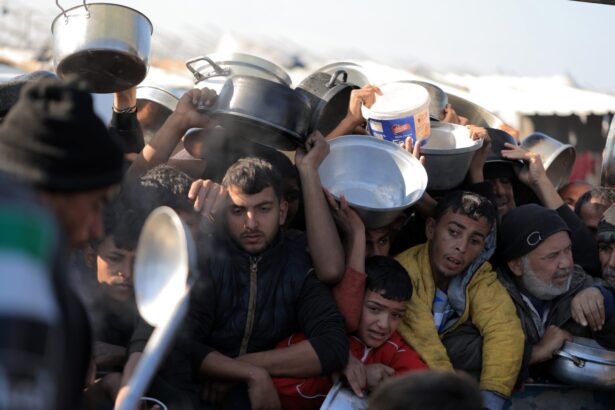The Biden administration is attempting to foster a fake dispute over famine numbers in Gaza to obscure the reality of genocide.
By Bryce Greene, Reposted from Mondoweiss
On December 23rd, the Famine Early Warning Systems Network (FEWSN), a project funded by the US Agency for International Development (USAID) released a report warning of a “famine scenario” that “continues to unfold in Northern Gaza.”
Based on the lack of aid and the number of people reported to be in the area, FEWS NET concluded that “it is highly likely that the food consumption and acute malnutrition thresholds for Famine (IPC Phase 5) have now been surpassed.” The organization estimated that absent any change of Israeli policy, they predict that “non-trauma mortality levels will pass the Famine (IPC Phase 5) threshold between January and March 2025, with at least 2-15 people dying per day.” The accepted threshold for famine would be two or more deaths a day per 10,000 people.
FEWS Net has been monitoring the humanitarian situation in Gaza since Israel’s attack began.
False dispute
The day after the report was published, the U.S. Ambassador to Israel, Jack Lew, publicly denounced the report in a tweet. He claimed that FEWSNET’s report was “relying on inaccurate data” and that “it is irresponsible to issue a report like this.”
The basis of his objection was the number of civilians currently in northern Gaza. The FEWS NET report included November assessments that estimated the population was up to 75,000. In his complaint, Lew cited more recent figures, combining COGAT’s estimate of 5,000-9,000 and UNRWA’s estimate of 7,000-15,000. Lew wrote that “it is now apparent that the civilian population in that part of Gaza is in the range of 7,000-15,000, not 65,000 – 75,000 which is the basis of this report.” To Lew, the use of November figures in the report undermines the report’s conclusions about a current famine in northern Gaza.
However, this complaint would only resonate with someone who has not actually read the report, which totals just three pages. While the report did cite the higher, earlier figures, to say this was the “basis of this report” would be completely false. The sentence after FEWS NET cited OCHA’s November figures, and the report cited UNRWA’s smaller figures from December:
More recent satellite-derived imagery suggests thousands of people evacuated in early December, 1 and efforts are underway to update the estimated size of the remaining population; an update from the UN Relief and Works Agency for Palestine Refugees in the Near East (UNRWA) on December 22 suggests the population may be as low as 10,000-15,000
The citation is clear that it is including the lower end of the numbers in their assessment:
The range of the estimated daily number of deaths (2-15 deaths per day, applying the crude death rate threshold for Famine of 2 deaths/10,000/day) captures the lowest possible base population for a Famine (IPC Phase 5) classification on the low end (10,000 people), and the maximum estimated base population (75,000 people) on the high end.
The report acknowledges some ambiguity from UNRWA’s numbers: “Based on the language in UNRWA’s update, it is unclear if the UN is suggesting the total population of North Gaza is 10,000-15,000, or if 10,000-15,000 people remain in a sub-set of areas.”
The FEWS NET report was also clear about the limitations to data collection, writing: “Amid increasingly infeasible conditions for the collection of data that is desired to definitively confirm whether the criteria for Famine (IPC Phase 5) are being met, analysis of the likelihood of Famine (IPC Phase 5) must rely on extrapolation, inference, empirical evidence, logic, and expert judgment.”
Any cursory reading completely undermines Lew’s claim that “inaccurate and outdated” figures were the “basis of this report.”
Distorting reality
Despite the baselessness of the State Department’s attack, FEWS NET succumbed to the pressure. The New York Times reported that the organization plans on adjusting its projections based on updated numbers – a surprising statement given that their current assessments included numbers from the day prior to publication. The Times also reported that FEWS Net stands by its assessment, but the report has been removed from their website (still accessible via the Wayback machine). In fact, while older reports on Gaza are still available, the FEWSNET interactive dashboard shows no information on Gaza at all.
Aid and Advocacy groups responded to the U.S. attack and FEWS Net retraction with swift condemnation. The Council on American Islamic Relations (CAIR) released a statement condemning the report’s removal:
To reject a report on starvation in northern Gaza by appearing to boast about the fact that it has been successfully ethnically cleansed of its native population is just the latest example of Biden administration officials supporting, enabling and excusing Israel’s clear and open campaign of genocide in Gaza.
Ken Roth of Human Rights Watch denounced the dispute:
“This quibbling over the number of people desperate for food seems a politicized diversion from the fact that the Israeli government is blocking virtually all food from getting in.”
By quickly denouncing the report, the U.S. ambassador shifted the focus of media coverage from the report’s conclusions to the new story about the Dispute. To audiences, the report’s conclusions are put on the back burner, and the most important story is the dispute. FEWS Net’s removal of the report only fueled this misdirection.
On Christmas Day, The New York Times published an article recounting the saga, highlighting Ambassador Lew’s complaints and framing the story as a dispute of numbers. The Times appears to have not read the report as it makes no reference to the fact that FEWS Net does cite more recent figures from UNRWA.
Israel’s starvation policy has been openly acknowledged both in Israel and in the US. Since at least October, the policy has been embodied by the so-called General’s Plan for clearing northern Gaza. The General’s Plan is the name given to the document from hawkish Israeli general Giora Eiland that urges the IDF to forcibly expel the population of the north, then seal off the area, treating anyone who remains as a military target.
In effect, this plan is the basis for a campaign of violent ethnic cleansing for the many who are unable or unwilling to comply with the IDF’s unlawful orders. Eiland, who has endorsed drastic measures, including allowing or encouraging epidemics in Gaza as part of Israel’s war efforts, has defended his plan in the Israeli press.
In Israel, this plan is openly discussed as a plan for northern Gaza. While Israel assured U.S. counterparts in private that this wasn’t their plan, Israel refused to publicly disavow th.e plan.
The entirety of this plan is advanced by the famine conditions reported by FEWS Net.
This phony dispute about the humanitarian reports in the North is designed to obscure these facts and pave the way for Israel’s continued assault on the people of Gaza. As Amnesty, Human Rights Watch, and numerous reports have corroborated, Israel has demonstrated a clear intent to commit genocidal acts against the Palestinians. US officials and media have been instrumental in running cover for this crime.
Bryce Greene is a PhD student, writer, and organizer. He co-founded Indiana University’s Palestine Solidarity Committee.
RELATED:
- The Case Against Joe Biden for Complicity in Genocide
- Gaza has turned into Biden’s most perplexing moral and foreign policy failure
- How Israel plans to whitewash its war crimes in Gaza
- What Would You Do With An Extra $320 Million?
- ‘Suffering horrifically’: 10 months of Israel’s ‘war on children’ in Gaza





